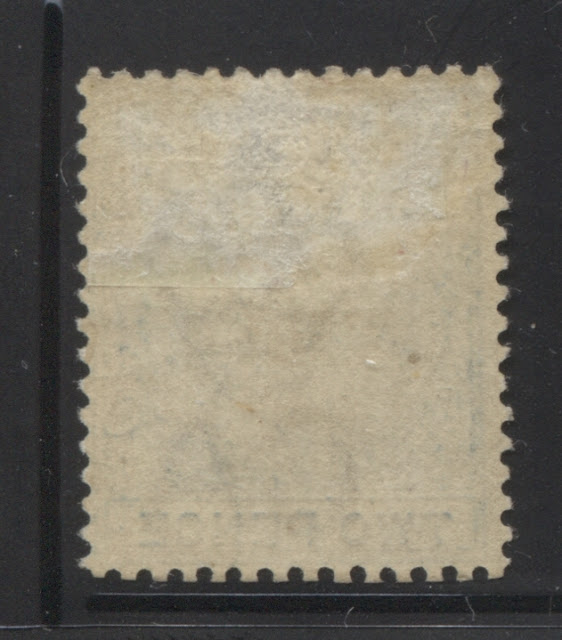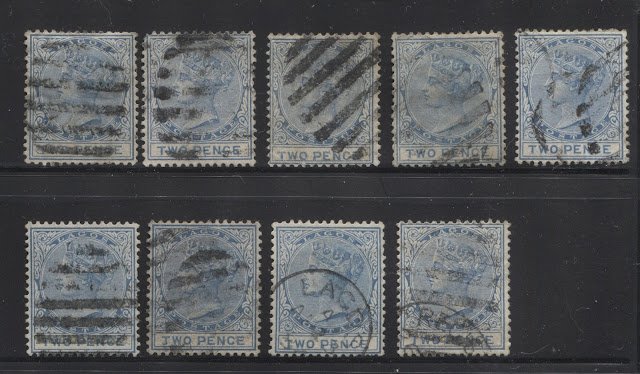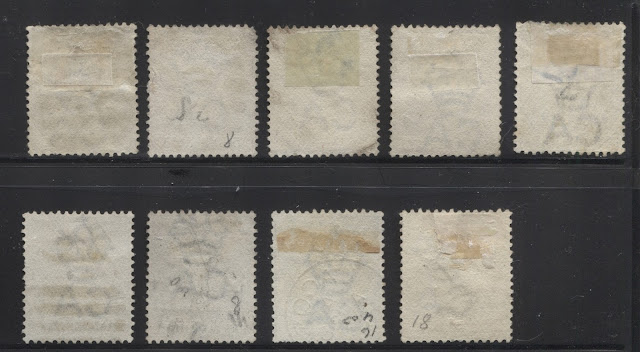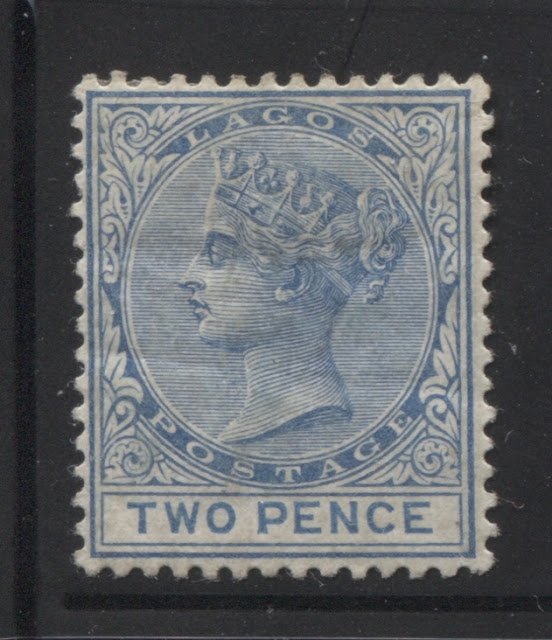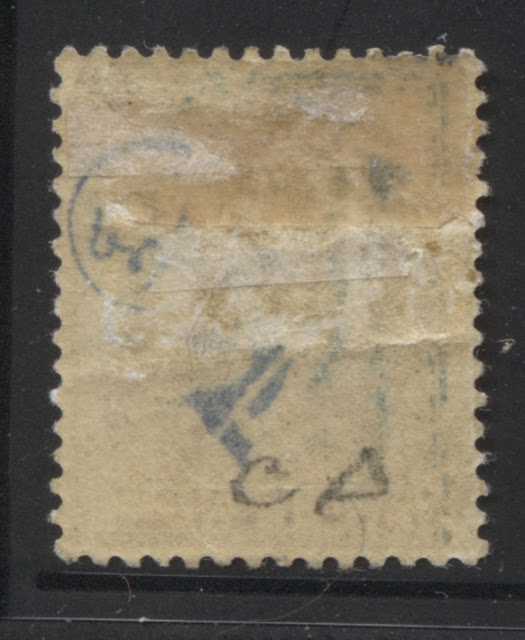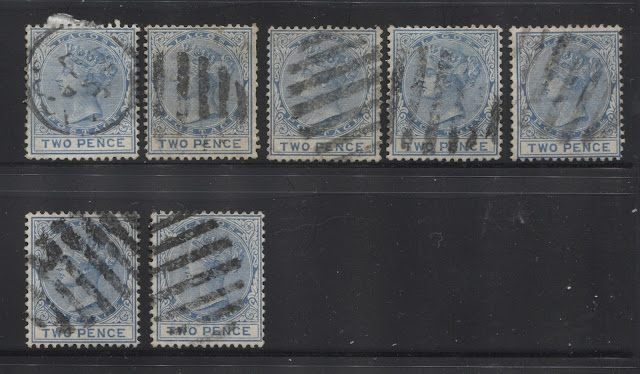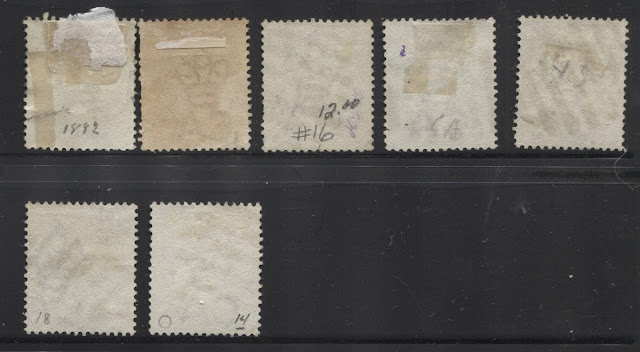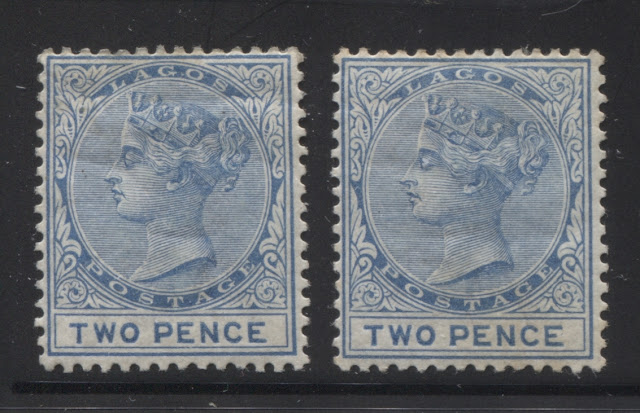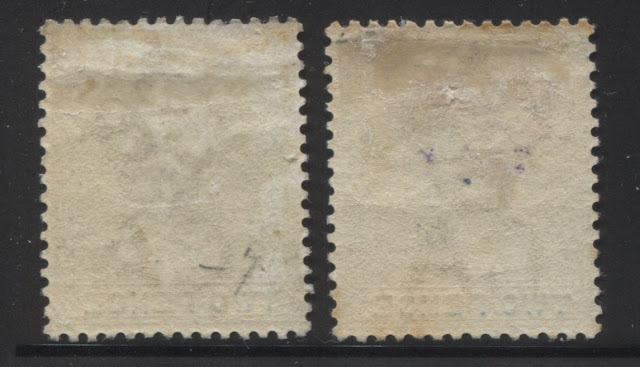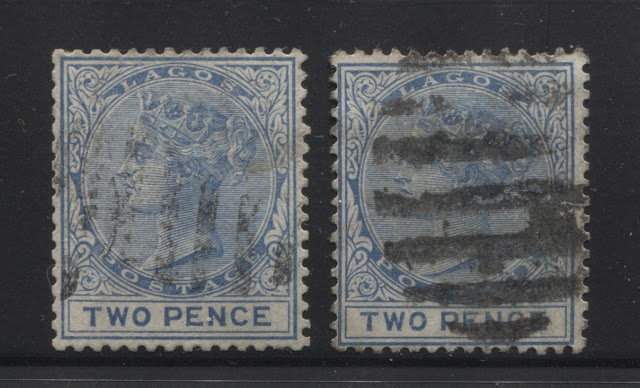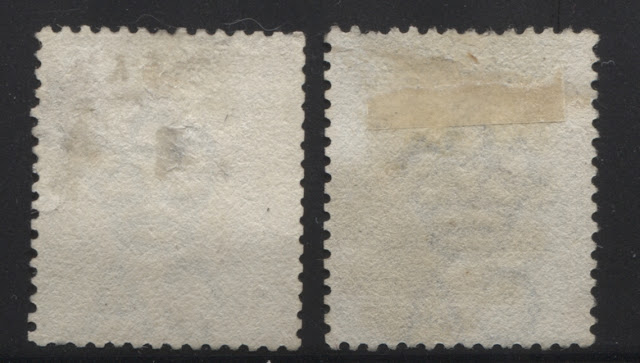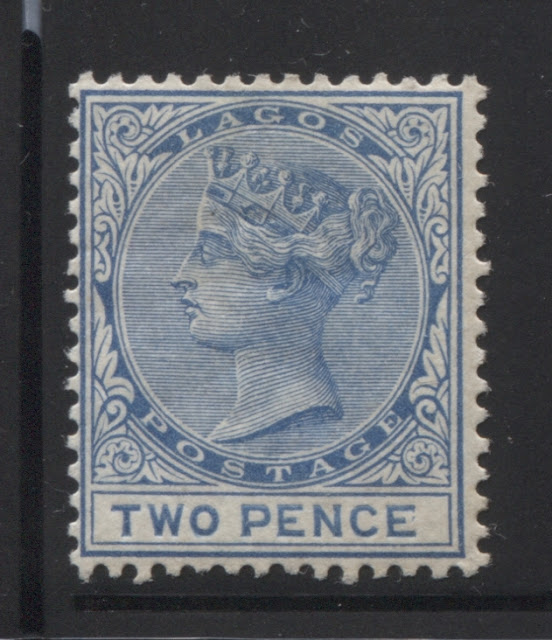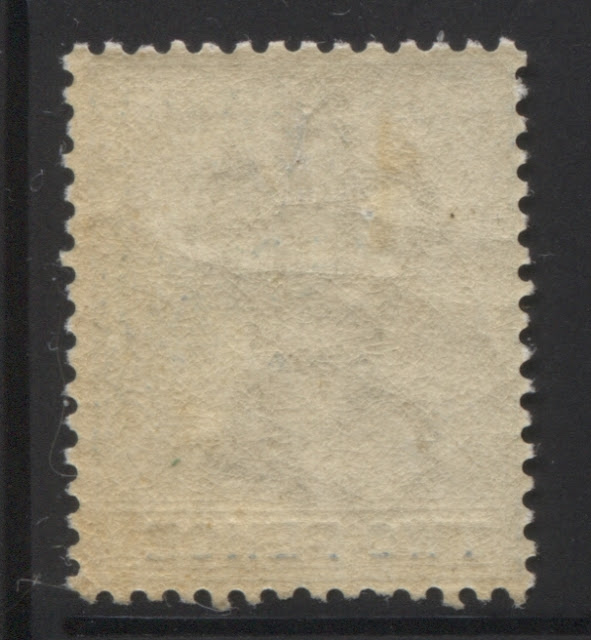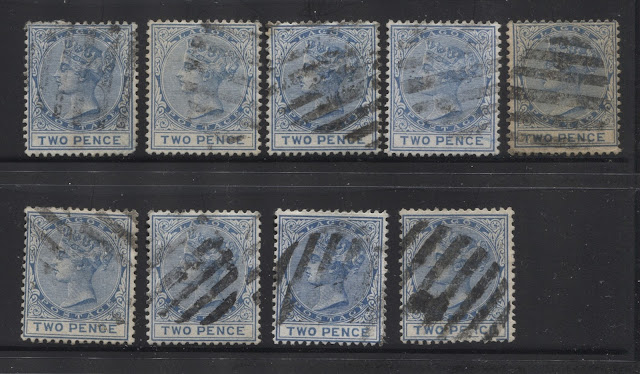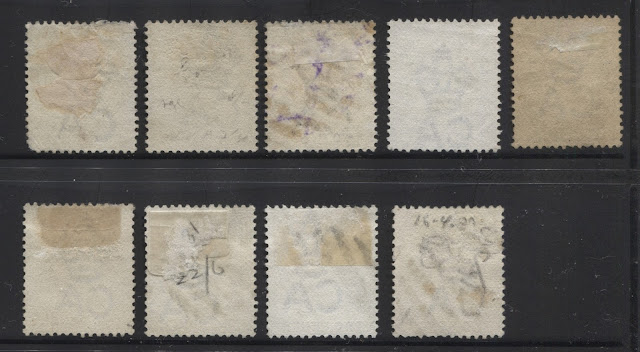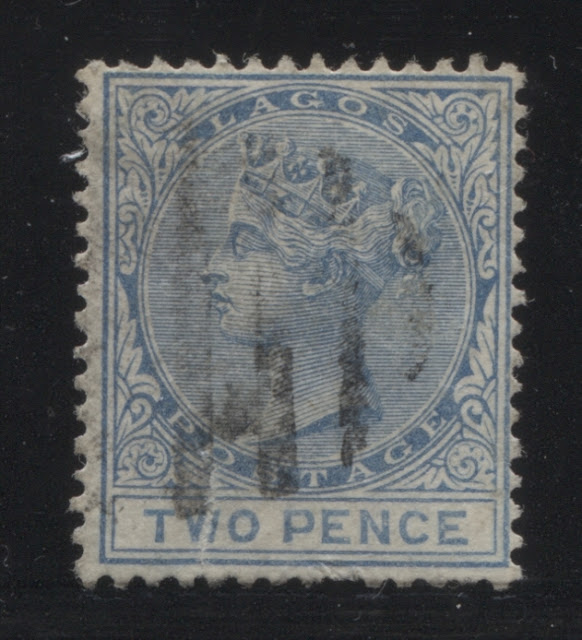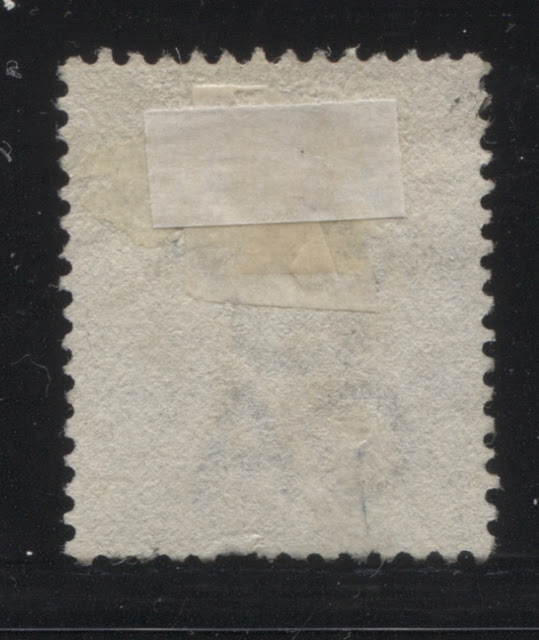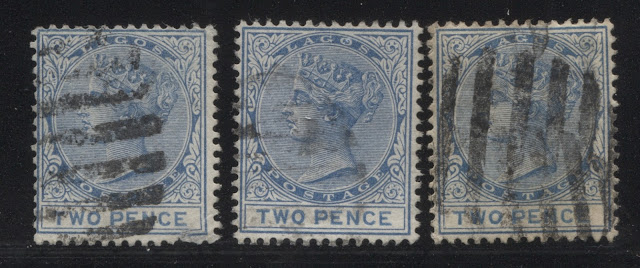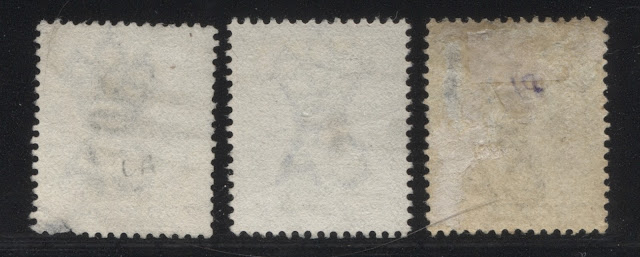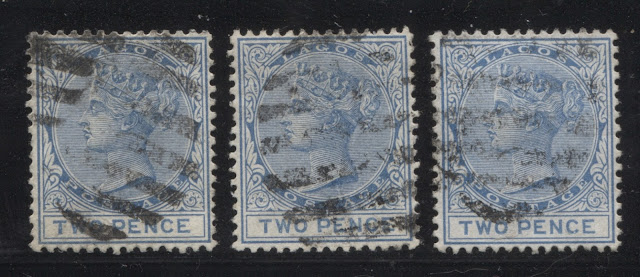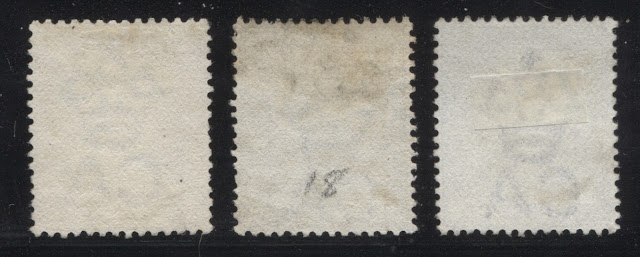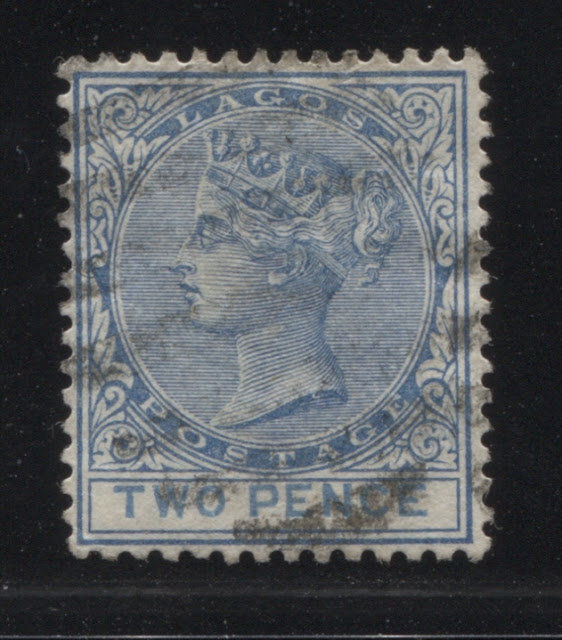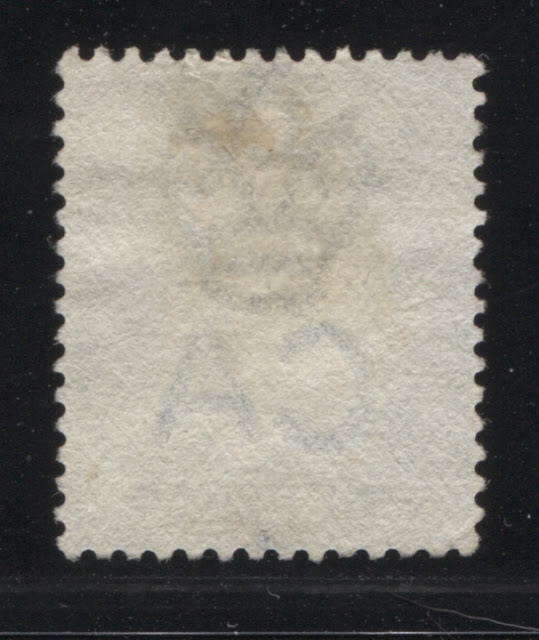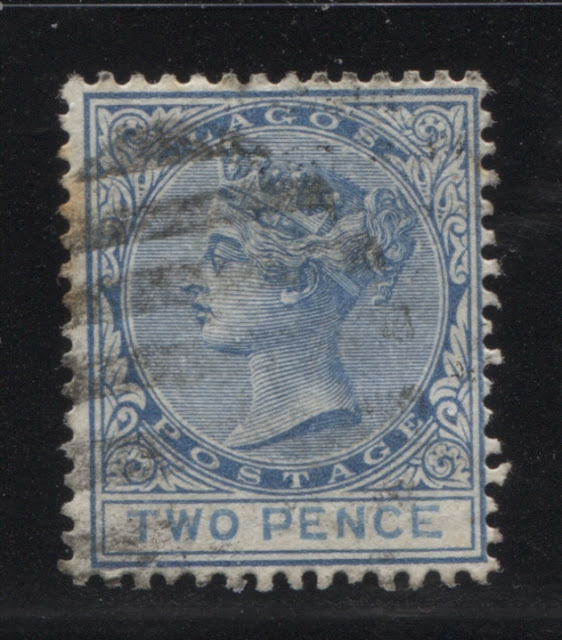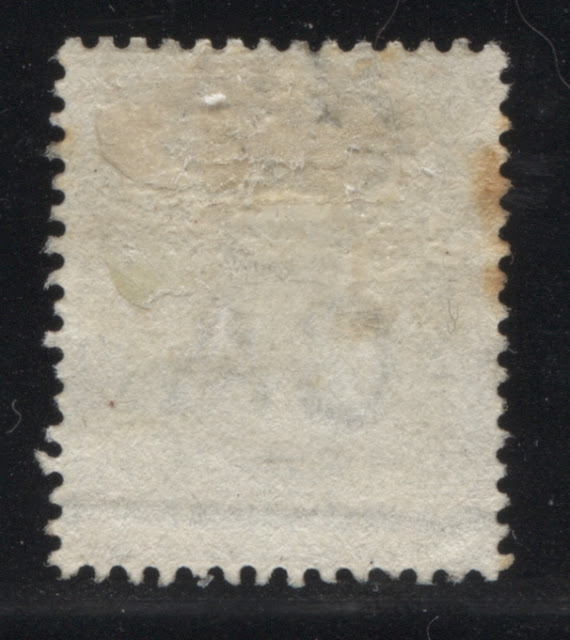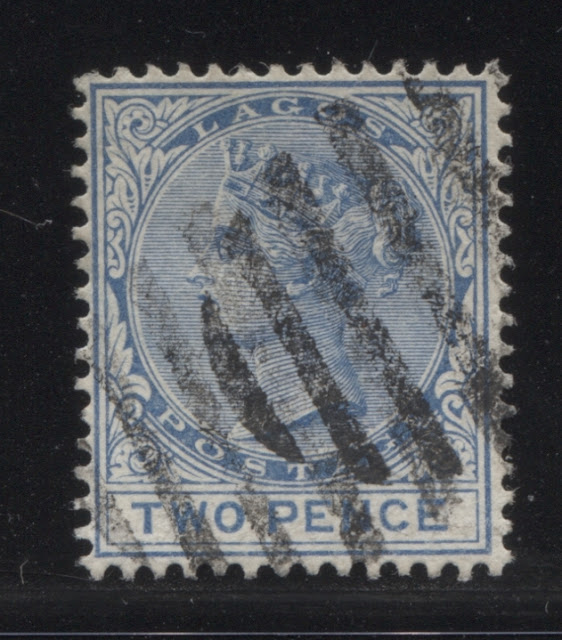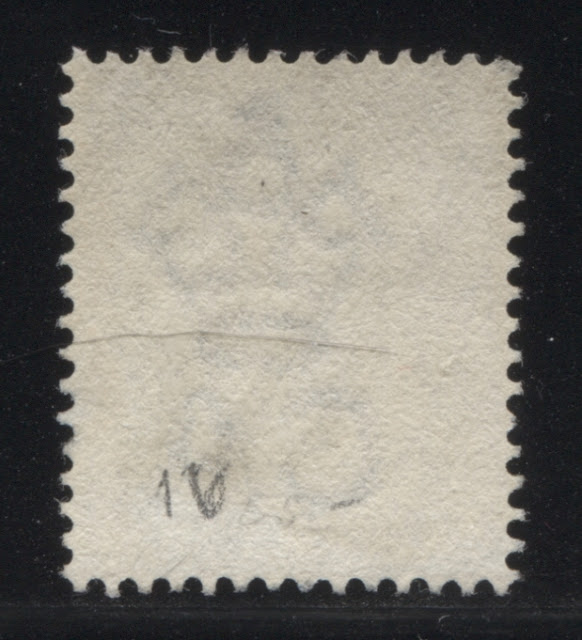Today's post continues my detailed exploration of the stamps of the 1882-1884 Crown CA keyplate issue of Lagos, that was in use briefly until the colony decided to comply with the colour regulations of the Universal Postal Union. Today, I will look at the 2d blue.
As I stated in my last post, Ince did not provide a detailed list of printings in his works. Because of that, coupled with the lack of dated postmarks in this period, it is not possible to definitively assign specific printings to specific dates. We do know that at this time that the colony was on the quarterly supply system with the crown agents. This means that there were shipments of stamps to the colony each and every month as they were needed. Now, this does not mean that there was a shipment of every value each quarter - only as supplies were exhausted. Historically, the 2d was only included with every second shipment until 1876, but after 1876, it was included with every shipment. The local letter rate was raised from 1d to 2d on March 22, 1879, so that throughout the period of this issue, this should have been a fairly heavily used stamp. However, the total quantity printed was about the same as the 1d, while there were more 4d stamps printed. Looking at the total quantity of stamps supplied since 1874 may shed some light as to how many printings there might have been:
1. The 1874-76 series produced 14,160 stamps over a 1 year period, in four shipments during that time.
2. The 1876-1879 series produced 49,140 stamps over a four year period, in six shipments, averaging 1 shipment per year, and 2 shipments in 1879, which is consistent with the increased demand resulting from the rate increase.
3. This series produced 32,640 stamps over an almost four year period. The number of shipments is not known, but is likely somewhere between 6 and 8 shipments.
So I am going to sort my stock of 5 mint examples and 37 used examples with a view to seeing how many different printings I can identify.
Printings
After careful sorting and comparison, I have identified ten groups of stamps that have different colour shades as to the head plates and duty plates.
Both the CDS cancel and the barred grid obilterator were contemporary during this period, although one can probably safely assign printings that are cancelled with predominantly CDS's to the last printings, while those cancelled only with the barred oval obliterators are likely to have come from the beginning of the period. That is of limited help with this particular value, as only two of my 37 used examples are canceled with CDS cancels. The remainder all appear to be cancelled with the 8-bar oval killer that was the prevalent cancellation of choice during this time.
As was the case with the 1d, paper and perforation are not much help here. All of the stamps are comb perforated 14. The paper is softer and of inferior quality to that found on the crown CC issues. The visibility of the watermark does vary outside fluid, from very faint, to highly visible. Usually on the back side, under a loupe, the paper will have a somewhat rough appearance. This seems to hold across all the printings, as we shall see.
The gum does vary a little bit. The earlier gum is thick and appears quite crackly under a loupe, as well as to the unaided eye. Later, as the period progresses, the gum becomes smoother and less crackly. Unfortunately, due to the rarity of mint examples, I only have five in my whole stock, and do not seem to have the full range of gum types, nor do I have mint examples of most printings I identified.
So, without further ado, lets take a look at the various printings that I identified.
Group One
In this first group of stamps, the head plate and the duty plate are slightly different colours. The head plate is close to a pure shade of blue. It is neither bright, nor dull, and is not greenish or greyish. The duty plate (words of value) on the other hand is a deep and slightly greenish blue. Here is my only mint example:
Now lets look at the backs:
Here the paper appears, soft, and smooth, with no obvious mesh, but with high visibility of the watermarks. The earlier printings tended to be on paper that did not show the watermark clearly, while the later printings also tend to show mesh. The appearance of this paper tends to suggest that these stamps are from a printing made sometime in 1883 or 1884.
Group Two
This group of stamps is very similar to the last one. The frame plate colour is the same blue, as the last group. The duty plate colour is also a deep greenish blue, except this time the blue is much, much closer in shade to the frame plate colour. If you look at these stamps without a loupe, the frame plate and duty plate colours appear to match, whereas the frame and duty plate colours are clearly different on the above group to the unaided eye.
Here is my only mint example:
Here you can hopefully see a very, very slight difference between the head plate and duty plate colours. However, the colours are a closer match than in the first group above.
Let's take a look at the gum on this one:
Now, lets look at some used examples:
Group Three
On this group, the frame plate shade is similar to the first two groups above, but is ever so slightly deeper. The real difference though is in the duty plate colour, which instead of being lighter and greener than the frame plate colour, is a deeper, fuller blue.
I have two mint examples of this stamp:
Here you can clearly see that the words "two pence" are a deeper, fuller blue than the rest of the stamp.
Let's take a look at the gum on these two stamps:
The gum is clearly crackly even in the scan, and appears almost identical to that found on the comb perforated stamps of the last crown CC issue. That strongly suggests that this is one of the earliest, if not the first printing.
I also have just two used examples:
Group Four
This is a really distinct printing. The blue of the frame plate is a deeper and brighter blue, while the duty plate colour is also deep blue, but with just the slightest hint of green.
Here is my last mint example:
As you can see, the frame colour is deeper than on all the other printings so far, as well as a bit brighter. Although very close to the duty plate colour, you should be able to see a very slight greenish tinge to the duty plate as compared to the rest of the stamp.
Let's see if the gum on this one is different from the others that we have looked at so far:
Again this gum is somewhat crackly in appearance, and looks similar to the gum from group three above. This tends to suggest that it may be an earlier printing, though in the scan the gum looks smoother, suggesting it is a later printing.
Now lets look at some used examples:
Let's see if we can see any clues on the back of these stamps that might help us determine where to place them:
Here we see both papers showing no mesh, and paper showing faint vertical mesh, which is consistent with a later, but probably not last printing. The cancels suggested this too. So I would guess that this printing was made sometime in late 1884.
Group Five
I only have one stamp from this group, and it is in poor condition, which may mean that the colour has simply faded somewhat. But here the frame and duty plate colours are more or less the same, and are a slightly duller version of the blue found in groups one through three.
Here is my only used example:
Group Six
In this group the frame and duty plate shades are very similar to group four, except that the duty plate colour is not quite as deep, and is closer to a true Prussian blue, which is a greenish blue. The scan below shows my three used examples:
It is difficult to tell whether these are 8-bar or 9-bar cancels. The one on the left certainly looks like it could be a 9-bar if that first bar below "two pence" is not the first one. But without being sure, it is not possible to say definitively.
Here are the backs of these three stamps:
Here two of the three stamps show clear vertical mesh. This suggests that this is a later printing.
Group Seven
This is very similar to group six, except that the duty plate colour is duller than the Prussian blue above, almost being a grey-blue. Again, I have no mint, but three used examples:
Group Eight
In each of the next three groups, I only have one single used stamp. On this stamp, the frame plate is a similar blue to the first three groups, and the fifth group. However, the duty plate colour is a very distinct, pale dull blue, quite unlike anything seen on the other printings.
Here is my only example:
Group Nine
Here the colour is the deeper, brighter blue of group four, but the duty plate is the pale dull blue of group eight above.
Here is my only example:
Group Ten
As I stated in my last post, Ince did not provide a detailed list of printings in his works. Because of that, coupled with the lack of dated postmarks in this period, it is not possible to definitively assign specific printings to specific dates. We do know that at this time that the colony was on the quarterly supply system with the crown agents. This means that there were shipments of stamps to the colony each and every month as they were needed. Now, this does not mean that there was a shipment of every value each quarter - only as supplies were exhausted. Historically, the 2d was only included with every second shipment until 1876, but after 1876, it was included with every shipment. The local letter rate was raised from 1d to 2d on March 22, 1879, so that throughout the period of this issue, this should have been a fairly heavily used stamp. However, the total quantity printed was about the same as the 1d, while there were more 4d stamps printed. Looking at the total quantity of stamps supplied since 1874 may shed some light as to how many printings there might have been:
1. The 1874-76 series produced 14,160 stamps over a 1 year period, in four shipments during that time.
2. The 1876-1879 series produced 49,140 stamps over a four year period, in six shipments, averaging 1 shipment per year, and 2 shipments in 1879, which is consistent with the increased demand resulting from the rate increase.
3. This series produced 32,640 stamps over an almost four year period. The number of shipments is not known, but is likely somewhere between 6 and 8 shipments.
So I am going to sort my stock of 5 mint examples and 37 used examples with a view to seeing how many different printings I can identify.
Printings
After careful sorting and comparison, I have identified ten groups of stamps that have different colour shades as to the head plates and duty plates.
Both the CDS cancel and the barred grid obilterator were contemporary during this period, although one can probably safely assign printings that are cancelled with predominantly CDS's to the last printings, while those cancelled only with the barred oval obliterators are likely to have come from the beginning of the period. That is of limited help with this particular value, as only two of my 37 used examples are canceled with CDS cancels. The remainder all appear to be cancelled with the 8-bar oval killer that was the prevalent cancellation of choice during this time.
As was the case with the 1d, paper and perforation are not much help here. All of the stamps are comb perforated 14. The paper is softer and of inferior quality to that found on the crown CC issues. The visibility of the watermark does vary outside fluid, from very faint, to highly visible. Usually on the back side, under a loupe, the paper will have a somewhat rough appearance. This seems to hold across all the printings, as we shall see.
The gum does vary a little bit. The earlier gum is thick and appears quite crackly under a loupe, as well as to the unaided eye. Later, as the period progresses, the gum becomes smoother and less crackly. Unfortunately, due to the rarity of mint examples, I only have five in my whole stock, and do not seem to have the full range of gum types, nor do I have mint examples of most printings I identified.
So, without further ado, lets take a look at the various printings that I identified.
Group One
In this first group of stamps, the head plate and the duty plate are slightly different colours. The head plate is close to a pure shade of blue. It is neither bright, nor dull, and is not greenish or greyish. The duty plate (words of value) on the other hand is a deep and slightly greenish blue. Here is my only mint example:
The greenish cast to the blue of the duty plate is difficult to see in the scan, but it becomes more apparent if you focus your eyes on the solid blue between the letters of "postage" and then allow your gaze to compare this colour to the "PE" of "Pence".
Let us take a look at the gum:
The gum is somewhat crackly, even without using a loupe. This tends to suggest that it is an early to mid printing, as the gum had become smoother on the later printings. However, on the scan, the gum appears relatively smooth, which suggests that it is not one of the earlier printings.
Now look at some used examples:
All of these except for the third stamp from the left on the bottom row are cancelled with the 8-bar oval obliterator. But the third stamp from the left on the bottom is cancelled with a Lagos CDS dated April 23, 1884, which is almost a year and a half before the last shipment in December 1885, and a little over two years after the first shipment. This tends to suggest to me that this printing is one of the middle ones. It it certainly one of the more common printings due to the fact that it accounts for 9 of the 37 used examples in my stock.Now lets look at the backs:
Here the paper appears, soft, and smooth, with no obvious mesh, but with high visibility of the watermarks. The earlier printings tended to be on paper that did not show the watermark clearly, while the later printings also tend to show mesh. The appearance of this paper tends to suggest that these stamps are from a printing made sometime in 1883 or 1884.
Group Two
This group of stamps is very similar to the last one. The frame plate colour is the same blue, as the last group. The duty plate colour is also a deep greenish blue, except this time the blue is much, much closer in shade to the frame plate colour. If you look at these stamps without a loupe, the frame plate and duty plate colours appear to match, whereas the frame and duty plate colours are clearly different on the above group to the unaided eye.
Here is my only mint example:
Here you can hopefully see a very, very slight difference between the head plate and duty plate colours. However, the colours are a closer match than in the first group above.
Let's take a look at the gum on this one:
Again, on the scan, the gum looks relatively smooth. It is very slightly crackly in reality, but not enough to suggest it is an early printing. Again, it would appear to be mid-range printing. Given, it's similarity to the first group I would say these printings were made very close together.
Now, lets look at some used examples:
Again, all the stamps except for the one at the top left appear to have been cancelled with the 8-bar oval. The upper left stamp is canceled with a Lagos CDS, that has an unclear date. It looks to me like January 27, 1887, which if correct, suggests that this might be one of the last printings. Of course, it could be one of the mid-printings close to the first group above that was simply used later.
Let's take a look at the backs:
Again, the paper is soft, has a fairly visible watermark, though less so than in group one, and no obvious mesh. Again, this suggests that this printing is from sometime between 1883 and 1884.Group Three
On this group, the frame plate shade is similar to the first two groups above, but is ever so slightly deeper. The real difference though is in the duty plate colour, which instead of being lighter and greener than the frame plate colour, is a deeper, fuller blue.
I have two mint examples of this stamp:
Here you can clearly see that the words "two pence" are a deeper, fuller blue than the rest of the stamp.
Let's take a look at the gum on these two stamps:
The gum is clearly crackly even in the scan, and appears almost identical to that found on the comb perforated stamps of the last crown CC issue. That strongly suggests that this is one of the earliest, if not the first printing.
I also have just two used examples:
The stamp on the right is definitely canceled with 8 bars, while the one on the left might be the 9 thinner bars, bit it is too unclear to be sure. So it is really difficult to tell when this printing is from.
Now, let's look at the backs of these two stamps:
Here we see, smooth paper, with no obvious mesh and barely any visibility of the watermark. This is consistent with this being an early printing.
Group Four
This is a really distinct printing. The blue of the frame plate is a deeper and brighter blue, while the duty plate colour is also deep blue, but with just the slightest hint of green.
Here is my last mint example:
As you can see, the frame colour is deeper than on all the other printings so far, as well as a bit brighter. Although very close to the duty plate colour, you should be able to see a very slight greenish tinge to the duty plate as compared to the rest of the stamp.
Let's see if the gum on this one is different from the others that we have looked at so far:
Again this gum is somewhat crackly in appearance, and looks similar to the gum from group three above. This tends to suggest that it may be an earlier printing, though in the scan the gum looks smoother, suggesting it is a later printing.
Now lets look at some used examples:
Here there are also no CDS's in the group. Most of these appear to be 8-bar ovals, but the middle stamp in the top row might well be the thinner 9-bar type, which was reported by Ince as being introduced in 1887. Some of the others on the bottom row might be 9-bar types, but it is hard to tell. Certainly, the bars look thinner on these compared with the first three groups above. This tends to suggest that this may be one of the later printings.
Let's see if we can see any clues on the back of these stamps that might help us determine where to place them:
Here we see both papers showing no mesh, and paper showing faint vertical mesh, which is consistent with a later, but probably not last printing. The cancels suggested this too. So I would guess that this printing was made sometime in late 1884.
Group Five
I only have one stamp from this group, and it is in poor condition, which may mean that the colour has simply faded somewhat. But here the frame and duty plate colours are more or less the same, and are a slightly duller version of the blue found in groups one through three.
Here is my only used example:
This appears to be an 8-bar oval cancel, so it could be one of the earlier printings.
Here is the back:
Here the paper is soft and smooth with no mesh, similar to the very earliest crown CC paper. So that suggests that this is one of the earliest printings.
Group Six
In this group the frame and duty plate shades are very similar to group four, except that the duty plate colour is not quite as deep, and is closer to a true Prussian blue, which is a greenish blue. The scan below shows my three used examples:
It is difficult to tell whether these are 8-bar or 9-bar cancels. The one on the left certainly looks like it could be a 9-bar if that first bar below "two pence" is not the first one. But without being sure, it is not possible to say definitively.
Here are the backs of these three stamps:
Here two of the three stamps show clear vertical mesh. This suggests that this is a later printing.
Group Seven
This is very similar to group six, except that the duty plate colour is duller than the Prussian blue above, almost being a grey-blue. Again, I have no mint, but three used examples:
These all have reasonably clear cancels, and looking at them carefully reveals them to be 8-bar ovals. So these could be earlier printings.
Here are the backs of these three stamps:
Group Eight
In each of the next three groups, I only have one single used stamp. On this stamp, the frame plate is a similar blue to the first three groups, and the fifth group. However, the duty plate colour is a very distinct, pale dull blue, quite unlike anything seen on the other printings.
Here is my only example:
This is definitely cancelled with 8-bars.
Let's take a look at the back of this one:
Again, this paper shows clear mesh, suggesting that it is a later printing.
Group Nine
Here the colour is the deeper, brighter blue of group four, but the duty plate is the pale dull blue of group eight above.
Here is my only example:
Again, it is difficult to tell with certainty, but this appears to be canceled with 8 bars. Interestingly, this example shows the truncated "N" in "Pence", which is a constant variety that first arises on the 1874 issue.
Let's take a look at the back of this one:
Here the paper shows no distinct mesh and is similar to the early crown CC paper. So this looks like an early printing.
Group Ten
This last group is also distinct in that the head plate and duty plate are identical in colour, and is a blue that is deeper than groups one through three, is similar to group four, but slightly duller.
Again, I give you my only used example:
The bars on this cancel are thin enough that it might be a 9-bar cancel. However, it is hard to be certain, without being able to see where the middle bar is in relation to the others.
Now, let us look at the back of this last stamp:
Once again, the paper shows no distinct mesh, suggesting that it is an early printing.
Suggested Order of the Printings
Based on the characteristics observed, the following groups would appear to be early printings made between January 1882 and mid to late 1883:
- Group three
- Group five
- Group nine
- Group ten
The following would appear to be middle printings made between mid 1883 and mid 1884:
- Group one
- Group two
- Group four (the latest of these three)
The following would appear to be late printings from mid 1884 to late 1885:
- Group six
- Group seven
- Group eight
The last groups would appear to be scarcer because the 2d slate, which replaced this stamp had already been issued starting in July 1884, so the number of blue stamps printed would have been much much less than before.
That concludes my discussion of the 2d blue from this series. Next week, I will look at the 3d chestnut.



